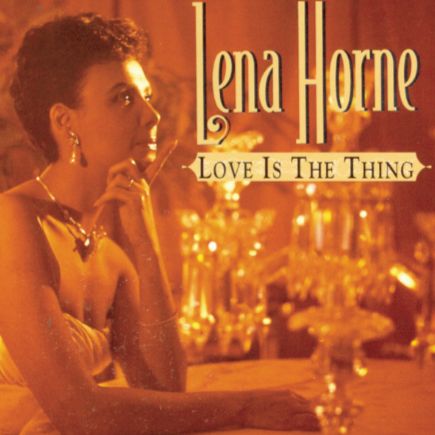Lena Horne, une voix de jazz et de liberté
Lena Horne fut bien plus qu’une chanteuse de jazz à la voix envoûtante: elle incarna l’élégance, la détermination et l’engagement d’une artiste qui sut s’imposer dans un monde marqué par les discriminations raciales. Son timbre raffiné, capable d’allier la sensibilité du blues à la sophistication du jazz, fit d’elle une figure incontournable, mais sa carrière fut aussi profondément marquée par les barrières sociales et politiques de son temps.
Ses débuts remontent à 1933, lorsqu’elle rejoint le chœur de danseurs du légendaire Cotton Club à Harlem. Ce lieu, fréquenté par l’élite blanche new-yorkaise, offrait paradoxalement une vitrine à de nombreux artistes afro-américains. Là, entourée de géants tels que Duke Ellington et Cab Calloway, elle forgea son style. Elle se révèle comme chanteuse dans un spectacle d’Adelaide Hall, interprétant As Long As I Live, et gagne rapidement en visibilité grâce au film The Duke Is Tops et à la revue Blackbirds of 1939.
En 1940, elle est engagée comme chanteuse par le big band de Charlie Barnet, puis collabore l’été suivant avec l’orchestre d’Artie Shaw, aux côtés de solistes comme Henry ‘Red’ Allen et Benny Carter. Parallèlement, sa résidence au Café Society, le club new-yorkais où Billie Holiday s’était révélée, lui ouvre les portes d’un public mixte et intellectuel. Lena Horne y enregistre notamment avec le pianiste Teddy Wilson, affirmant sa place parmi les grandes voix du jazz.
Sa carrière prend une dimension mythique avec Stormy Weather (1943), chanson devenue son emblème. Son interprétation poignante de ce standard, conjuguée à son élégance scénique, séduisit un large public et marqua durablement l’imaginaire collectif. Lena Horne brilla aussi au cinéma, jouant dans Cabin in the Sky de Vincente Minnelli (1942) et Stormy Weather d’Andrew Stone (1943), où elle révéla son talent d’actrice et de chanteuse. Mais Hollywood lui opposa souvent des rôles stéréotypés, reflets des préjugés de l’époque.
Au-delà de son art, Lena Horne fit de sa notoriété un outil de lutte. Militante infatigable pour l’égalité, elle participa à la Marche sur Washington en 1963 et s’engagea contre les injustices raciales, devenant une voix puissante du mouvement des droits civiques. Elle fut également l’une des premières Afro-Américaines à signer un contrat de longue durée avec une grande maison de disques, MGM, ouvrant la voie à d’autres artistes noirs.
Lena Horne, una voz de jazz y de libertad
Lena Horne fue mucho más que una cantante de jazz con una voz cautivadora: encarnó la elegancia, la determinación y el compromiso de una artista que supo imponerse en un mundo marcado por la discriminación racial. Su timbre refinado, capaz de unir la sensibilidad del blues con la sofisticación del jazz, la convirtió en una figura esencial, aunque su carrera estuvo también profundamente condicionada por las barreras sociales y políticas de su tiempo.
Sus inicios se remontan a 1933, cuando se unió al coro de bailarines del legendario Cotton Club de Harlem. Este lugar, frecuentado por la élite blanca neoyorquina, ofrecía paradójicamente una vitrina a numerosos artistas afroamericanos. Allí, rodeada de gigantes como Duke Ellington y Cab Calloway, forjó su estilo. Se dio a conocer como cantante en un espectáculo de Adelaide Hall interpretando As Long As I Live, y pronto ganó visibilidad con la película The Duke Is Tops y la revista Blackbirds of 1939.
En 1940 fue contratada por la big band de Charlie Barnet y, al verano siguiente, colaboró con la orquesta de Artie Shaw, junto a solistas como Henry « Red » Allen y Benny Carter. Paralelamente, su residencia en el Café Society, el mismo club donde se reveló Billie Holiday, le permitió encontrarse con un público mixto e intelectual. Allí grabó con el pianista Teddy Wilson, consolidando su lugar entre las grandes voces del jazz.
Su carrera adquirió una dimensión mítica con Stormy Weather (1943), canción que se convirtió en su emblema. Su interpretación conmovedora de este estándar, unida a su elegancia escénica, conquistó a un amplio público y dejó una huella indeleble en el imaginario colectivo. También brilló en el cine, actuando en Cabin in the Sky de Vincente Minnelli (1942) y Stormy Weather de Andrew Stone (1943), donde mostró su talento como actriz y cantante. Sin embargo, Hollywood le impuso a menudo papeles estereotipados, reflejo de los prejuicios de la época.
Más allá de su arte, Lena Horne convirtió su notoriedad en un instrumento de lucha. Activista incansable por la igualdad, participó en la Marcha sobre Washington en 1963 y se comprometió contra la injusticia racial, erigiéndose en una voz poderosa del movimiento por los derechos civiles. Fue también una de las primeras afroamericanas en firmar un contrato de larga duración con una gran discográfica, MGM, abriendo el camino a otros artistas negros.
Lena Horne, una voce di jazz e di libertà
Lena Horne fu molto più di una cantante jazz dalla voce incantevole: incarnò l’eleganza, la determinazione e l’impegno di un’artista che seppe affermarsi in un mondo segnato dalla discriminazione razziale. Il suo timbro raffinato, capace di unire la sensibilità del blues con la sofisticazione del jazz, la rese una figura imprescindibile, anche se la sua carriera fu profondamente segnata dalle barriere sociali e politiche del suo tempo.
I suoi esordi risalgono al 1933, quando entrò nel coro di ballerini del leggendario Cotton Club di Harlem. Questo locale, frequentato dall’élite bianca newyorkese, offriva paradossalmente una vetrina a numerosi artisti afroamericani. Lì, circondata da giganti come Duke Ellington e Cab Calloway, affinò il suo stile. Si rivelò come cantante in uno spettacolo di Adelaide Hall interpretando As Long As I Live, e guadagnò presto visibilità con il film The Duke Is Tops e la rivista Blackbirds of 1939.
Nel 1940 fu ingaggiata dalla big band di Charlie Barnet e, l’estate successiva, collaborò con l’orchestra di Artie Shaw, accanto a solisti come Henry “Red” Allen e Benny Carter. Parallelamente, la sua residenza al Café Society, lo stesso club dove si era affermata Billie Holiday, le permise di incontrare un pubblico misto e intellettuale. Qui registrò anche con il pianista Teddy Wilson, consolidando il suo posto tra le grandi voci del jazz.
La sua carriera assunse una dimensione mitica con Stormy Weather (1943), brano che divenne il suo emblema. La sua interpretazione toccante di questo standard, unita all’eleganza scenica, conquistò un vasto pubblico e lasciò un segno indelebile nell’immaginario collettivo. Brillò anche nel cinema, recitando in Cabin in the Sky di Vincente Minnelli (1942) e in Stormy Weather di Andrew Stone (1943), dove dimostrò il suo talento di attrice e cantante. Tuttavia, Hollywood le impose spesso ruoli stereotipati, riflesso dei pregiudizi dell’epoca.
Oltre alla sua arte, Lena Horne fece della sua notorietà uno strumento di lotta. Attivista instancabile per l’uguaglianza, partecipò alla Marcia su Washington nel 1963 e si impegnò contro l’ingiustizia razziale, diventando una voce potente del movimento per i diritti civili. Fu inoltre una delle prime afroamericane a firmare un contratto di lunga durata con una grande casa discografica, la MGM, aprendo la strada ad altri artisti neri.
Lena Horne, a voice of jazz and freedom
Lena Horne was far more than a jazz singer with a captivating voice: she embodied the elegance, determination, and commitment of an artist who managed to rise in a world marked by racial discrimination. Her refined tone, blending the sensitivity of the blues with the sophistication of jazz, made her an essential figure, though her career was deeply shaped by the social and political barriers of her time.
Her beginnings date back to 1933, when she joined the chorus line at the legendary Cotton Club in Harlem. This venue, frequented by New York’s white elite, paradoxically offered a showcase for many African American artists. There, surrounded by giants like Duke Ellington and Cab Calloway, she honed her craft. She first emerged as a singer in a show by Adelaide Hall, performing As Long As I Live, and quickly gained recognition through the film The Duke Is Tops and the revue Blackbirds of 1939.
In 1940, she was hired by Charlie Barnet’s big band and, the following summer, collaborated with Artie Shaw’s orchestra, alongside soloists such as Henry “Red” Allen and Benny Carter. At the same time, her residency at Café Society—the same club where Billie Holiday had made her name—introduced her to a mixed, intellectual audience. There she also recorded with pianist Teddy Wilson, securing her place among the great voices of jazz.
Her career reached legendary status with Stormy Weather (1943), a song that became her signature. Her poignant interpretation of this standard, combined with her stage elegance, captivated a wide audience and left a lasting mark on the collective imagination. Horne also shone in Hollywood, appearing in Cabin in the Sky by Vincente Minnelli (1942) and Stormy Weather by Andrew Stone (1943), where she revealed her talent as both singer and actress. Yet Hollywood often confined her to stereotypical roles, reflecting the prejudices of the time.
Beyond her artistry, Lena Horne turned her fame into a tool of activism. A tireless advocate for equality, she took part in the 1963 March on Washington and spoke out against racial injustice, becoming a powerful voice of the civil rights movement. She also made history as one of the first African American women to sign a long-term contract with a major record label, MGM, paving the way for future Black artists.



